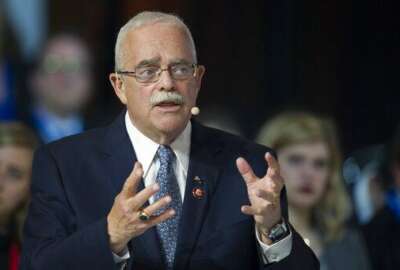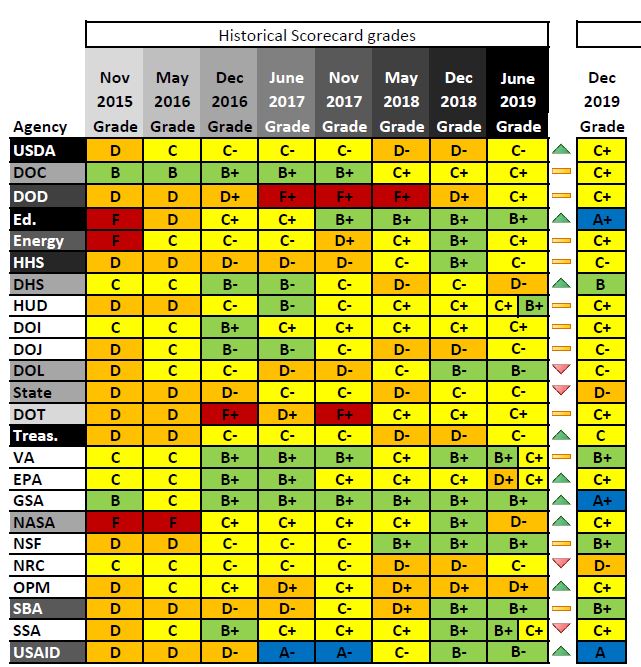
GSA, Education, USAID receive ‘As’ on FITARA scorecard
The House Oversight and Reform Committee released the ninth version of the Federal IT Acquisition Reform Act (FITARA) scorecard with 20 of 24 agencies improving or...
It took five years, but the vision Congress and federal technology leaders had for the Federal IT Acquisition Reform Act (FITARA) is becoming a reality.
In the 9th version of the FITARA scorecard, released by the House Oversight and Reform Committee on Wednesday, three agencies—the Department of Education, the General Services Administration and the U.S. Agency for International Development—received “A” grades. This is the first time in the history of the scorecard that more than one agency received the top rating, and it’s the third straight report card that no agency received an “F” grade.
In all, nine agencies saw their grades increase and four received lower grades since the June scorecard.

“This is the best scorecard ever. Nine agencies moved forward. There are three ‘As,’ we have not seen that in a long time. And certainly when we look back when we started in November of 2015, there were Fs and Ds and only two Bs,” said Federal CIO Suzette Kent at the ATARC IT Modernization summit. “A scorecard is a nice place to take a checkpoint and demonstrate what’s been done.”
Rep. Gerry Connolly (D-Va.), the chairman of the Oversight and Reform Subcommittee on Government Operations, said the average score in November 2015 under the first scorecard was a “D,” and it’s now a “C+” at the subcommittee’s hearing on Wednesday.
“Progress in federal IT takes political will, and the recognition that the CIO needs a seat at the leadership table and a critical role in the agency’s management decisions,” Connolly said in his opening statement. “The stakes for proper FITARA implementation are high. When executed well, government IT can produce savings and efficiencies, provide better customer experience and improve government’s knowledge and decision making. The benefits of effective IT in federal agencies are too great to ignore and this subcommittee will not waiver in its oversight of IT and acquisition and management principles.”
CIO reporting structure fixed
The Homeland Security Department made the biggest jump, earning a “B” after receiving a “D-” in the last report card. DHS acting CIO Beth Cappello testified before the subcommittee along with NASA CIO Renee Wynn. NASA received a “C+,” up from a “D-” last time.
Both agencies improved thanks, in part, to changing the reporting structure of their respective CIOs. NASA’s Wynn now reports directly to the administrator, and DHS modified its structure to give the CIO better access to the secretary.
Carol Harris, the director of IT management issues at the Government Accountability Office, said along with NASA and DHS, the Treasury Department and USAID also made significant enough changes to warrant improved scores.
“Progress would not have happened without your oversight,” Harris said to the subcommittee.
Connolly and Rep. Mark Meadows (R-N.C.), the ranking member of the subcommittee, wrote a letter to after the June hearing asking why the CIO didn’t report directly to the NASA administrator.
Agency progress becomes even more obvious in the scorecard’s subcategories. The committee says 21 agencies received “As” under the MEGABYTE Act implementation, which is focused on creating and maintaining software license inventories. The data center and CIO authorities subcategories also movement with 10 agencies receiving top marks.
Kent said the fact that so many agencies received “As” in the subcategories also is a good thing, but more importantly it gives OMB and the CIOs an opportunity to start thinking where they can go next.
“I look forward to the ways as we go forward that we seek to start to measure the things beyond infrastructure and operational maturity and look at our progress toward digital government and citizen services,” she said. “I’m giving a hand to all of those agencies who actually delivered those results and get to celebrate, and the fact there are ‘As’ is a fantastic thing.”
Driving change not just by the scorecard
Agencies continue to struggle with the implementation of the Modernizing Government Technology (MGT) Act, due mainly to the lack of creating working capital funds, and with their cybersecurity efforts under the Federal Information Security Management Act (FISMA). The scorecard showed 15 of 24 agencies received “Cs” or “Ds” under MGT, and 16 of 24 received a mark of a “C” or below.
Kent said despite the lower scores on cyber, for instance, it doesn’t mean agencies aren’t making progress.
“While grades may be a flat thing, what [the subcategories] really signal is a connection of the technology capability to the leadership of the agency, and using technology to truly drive change. That was part of the both the MGT Act and the executive order around CIO authorities,” she said. “It’s exciting to be in the dialogues and be in the conversations with agency secretaries or deputy secretaries or assistant secretaries for management and the CIOs where the conversation is about how do we use technology to achieve this? When we do things like have mission serving people talking about the power that new capabilities have brought to their ability to deliver.”
At the same time, Kent is a big supporter of the scorecard because it holds agencies accountable to meeting important goals.
“There are sometimes where I’m looking forward to ways we put more measures around things that are important to citizens and they are important to constituents and they demonstrate that terrific work. It’s great we have a software inventory, but those are the things that we should do every day. It’s really impressive if we make progress toward digital delivery of citizen services. Those are the kinds of things that are important in the scorecard. In this environment, I’m very happy there is a place we can drive conversations with Congress about the importance of technology.”
Kent said there are ongoing conversations about the elements and timing of FITARA scores. She said the FITARA oversight doesn’t necessarily sync well with the FISMA scores.
“The goal doesn’t change, but it’s more around how we measure it and what are the increments where you can actually show progress? That is the really big thing is in some of those areas driving change in six months is more difficult,” Kent said. “We want to use the scorecard as a way to highlight progress. As we accomplish things or as there are new sets of challenges that we need to measure, we need to progress the scorecard to think about that.”
Copyright © 2025 Federal News Network. All rights reserved. This website is not intended for users located within the European Economic Area.
Jason Miller is executive editor of Federal News Network and directs news coverage on the people, policy and programs of the federal government.
Follow @jmillerWFED
Related Stories





